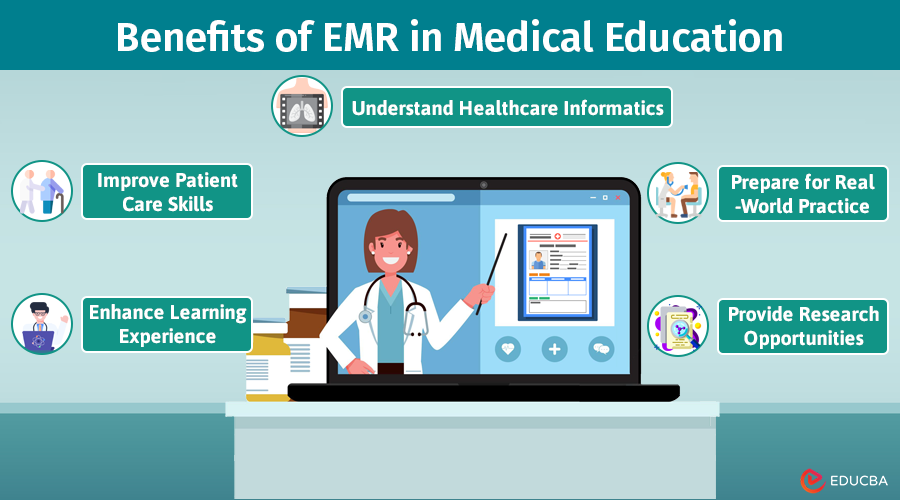What is EMR in Medical Education?
EMR in medical education is an electronic medical record to manage patient information instead of traditional paper records. It provides a comprehensive and accessible record of a patient’s medical history, including:
- Medical History: Diagnoses, medication lists, and allergies.
- Treatment Records: Dates and details of treatments and immunizations.
- Lab Results and Radiology Images: Results from tests and imaging studies.
88% of office-based physicians use EMR systems, highlighting their importance and prevalence in modern healthcare. Learning to use EMRs is crucial for future doctors and healthcare workers, as it prepares them to manage and analyze patient data effectively in real-world settings. In this article, we will learn about the benefits and challenges of EMR in medical education.
History and Evolution of EMRs
Here is a broad overview of EMR history:
- 1960s: In the 1960s, developers created EMRs as digital versions of paper medical charts. However, their use was limited and not widely adopted during this period.
- Late 2000s: The widespread adoption of EMRs began in the late 2000s. The Health Information Technology for Economic and Clinical Health (HITECH) Act largely drove this shift by promoting the use of electronic health records.
- HITECH Act: This legislation provided financial incentives to healthcare organizations implementing EMRs. The Act played a crucial role in accelerating the adoption and integration of EMRs across the healthcare industry.
- Post-HITECH Era: Since the implementation of the HITECH Act, EMRs have become a standard component of modern healthcare, significantly improving the quality and efficiency of patient care.
How EMR is Reshaping Medical Education?
Medical schools worldwide increasingly recognize the importance of Electronic Medical Record (EMR) training and are incorporating it into their curricula. Here is how EMR is transforming medical education:
- Integration into Curricula: Medical schools now include EMR education as a core component of their programs. This ensures that students acquire essential skills for modern healthcare environments.
- Simulated Clinical Environments: Students practice using EMR systems in simulated clinical settings that mimic real-world scenarios. This hands-on approach allows them to:
- Navigate patient records.
- Generate clinical notes from virtual data.
- Order tests and interpret results.
All of this takes place in a safe learning environment. This effectively bridges the gap between theory and practice.
- Continuous Learning Model: Harvard Medical School exemplifies this approach by integrating the EMR curriculum across all four years of medical school. This model helps students develop EMR skills gradually and use them consistently throughout their training.
Benefits of EMR in Medical Education
Here are some benefits of EMR in medical education:
1. Enhance Learning Experience
Through interactive studies, students can explore detailed patient cases and learn about different treatments. This helps them better understand how to make clinical decisions.
2. Improve Patient Care Skills
EMR training teaches students how to document patient information correctly and use tools to diagnose and plan treatments.
3. Understand Healthcare Informatics
Students learn how to collect, report, and analyze healthcare data. They become skilled at finding patterns in large amounts of data and understand the importance of sharing data between healthcare systems.
4. Prepare for Real-World Practice
Students gain practical experience by using EHR systems similar to those used in hospitals. They will be familiar with EMR workflows and processes when they finish their education.
5. Provide Research Opportunities
EMR systems provide access to anonymized patient data for research. Students can analyze this data to understand healthcare better and improve treatment methods.
Overcoming Challenges of EMR in Medical Education
Here is a clearer look at some challenges and potential solutions:
1. Complex EMR Interfaces
Challenge: Students may find EMR systems intimidating due to their complex interfaces and numerous functionalities. This can be overwhelming, especially for those who are new to technology.
Solution: Implement user-friendly EMR systems and provide comprehensive training to help students become comfortable with these tools. Hands-on practice and simplified tutorials can ease the learning curve.
2. Privacy and Data Security
Challenge: Proper ethics and health informatics law training ensures students understand privacy and data security issues.
Solution: The curriculum should include rigorous training on data privacy laws and ethical considerations to prepare students for real-world scenarios.
3. High Costs and Logistical Issues
Challenge: Implementing EMR training programs involves significant software, hardware, and faculty training investments. Additionally, keeping the training up-to-date with evolving technology and regulations is challenging.
Solution:
- Plan for ongoing investment and updates.
- Consider phased implementation and partnerships with EMR vendors for support and training resources.
- Regularly review and adjust the curriculum to stay current with technological and regulatory changes.
4. Balancing Technology and Patient-Centered Care
Challenge: We need to balance teaching contemporary EMR skills with traditional clinical-based learning while maintaining a patient-centered approach.
Solution: Design a curriculum that integrates EMR training with traditional medical education. Highlight the need to balance using technology with a compassionate, personal approach to patient care.
Final Thoughts
Integrating EMR in medical education is a big step to training future healthcare professionals. It enhances learning, improves patient care, and opens new research opportunities. As EMR skills become essential in medical practice, incorporating EMR training in medical programs helps students handle the complexities of modern, data-driven healthcare. Investing in EMR education is investing in the future of healthcare, preparing students to be skilled, tech-savvy, and data-literate physicians.
Recommended Articles
We hope you found this guide on “EMR in Medical Education” insightful. Explore these recommended articles for more on integrating technology in healthcare training and enhancing medical education.



